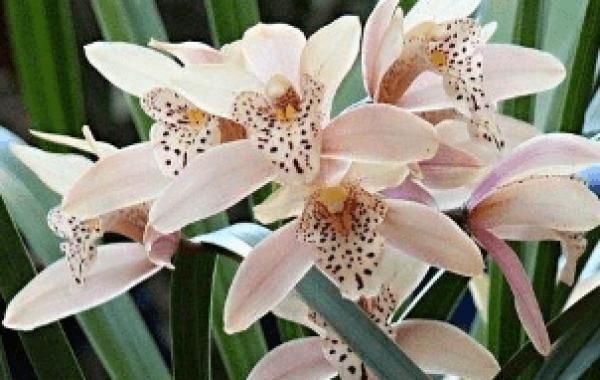Florescence Management of Cymbidium

Gentleman orchid as its name is like a modest gentleman, growing up is particularly attractive, no matter when it is blooming or not, it is a very good ornamental plant, many people like to raise a pot, its leaves are green, flowering clusters, attractive. However, when raising orchids, we will encounter a lot of unsatisfactory places, for example, the leaves of orchids turn yellow, but it is more common.
The gentleman orchid plant shape is dignified, the leaf arrangement is neat, the leaf color is greenish and moist, it is known to watch the flowers rather than appreciate the leaves, it is a kind of flowers that people like to breed very much. So do you know how to choose a gentleman orchid? Let's take a look at the selection skills of gentleman orchid with the editor. To evaluate the quality of Cymbidium varieties, its leaves account for a large proportion. So what are the characteristics of the leaves of the top-grade magnolia? 1. The leaves of the top-grade magnolia should be short and wide, with a length of between 9 cm and 12 cm, the ratio of length to width within 4:1, and some varieties can reach 2:1 or even 1:1, such as Henglan.
The flowering period of Magnolia is mostly from December to March, and the flowering period is the peak ornamental period. in this period, corresponding measures should be taken to ensure its normal flowering, large and colorful flowers and increase the ornamental value. So, what are the technologies? How to manage the flowering period of Cymbidium? The following editor will make an introduction for you.
First, watering correctly
1. Water quality problem
We usually use tap water to water flowers, but because tap water contains a small amount of substances harmful to orchids, it is harmful to the growth of orchids. In addition, there is a large temperature difference between tap water and basin soil, directly watering flowers with tap water to stimulate the root is not conducive to the growth of orchids, so if you use tap water to irrigate orchids, tap water should be placed indoors for two days. In this way, the harmful substances in the water, such as bleach, can be evaporated or precipitated, and the water temperature can reach or narrow the gap with the basin soil.
two。 Pay attention to watering quantity and watering times
The gentleman orchid is watered in winter, such as high indoor temperature and low humidity, it can be watered every 2-3 days. If the room is very low, it can be watered once a week. Each watering should be thoroughly watered, but do not leak to prevent nutrient loss. The watering time should be in the morning, because the room temperature in winter is low, and the water temperature in the morning is closer to the room temperature and basin soil temperature. At this time, watering does not stimulate the root system, which can make the orchid grow and develop at a suitable temperature for a longer time.
3. Don't usually use a spray can for watering.
Because before the winter flower, the gentleman orchid is in the period of drawing arrows, so it is easy to make the scape and stamens wet and rot by spraying water with a spray can at this time.
Second, how to apply fertilizer
The timely supply of fertilizer is the key to the flowering of Magnolia. Gentleman orchid likes fertilizer, especially before flowering, nitrogen, phosphorus, potassium fertilizer, nitrogen and potassium fertilizer can make scape strong, timely, phosphate fertilizer can make flowers beautiful, but also promote flowering and seed setting. Basal fertilizer can be applied once or twice before flowering, with an interval of 45 to 60 days.
Fertilization types are mainly oil plant fertilizer, such as sesame, castor, etc., after stir-frying, add appropriate amount of potassium dihydrogen phosphate or bone powder, run a 2 cm to 4 cm deep ditch around the flowerpot, spread the fertilizer along the edge of the ditch and cover it with soil evenly, do not make the root touch fertilizer, lest the flower root rot.
On the basis of applying base fertilizer, topdressing should be applied every 7 to 15 days. Topdressing can use bean cake water, fish fertilizer water or basic fertilizer soaked in the container, after ripening, take one tablespoon each time, add 2 water, pour around the soil surface. Be careful not to pour it in the pot or on the flowers and leaves.
Third, pay attention to adjust the indoor temperature
The suitable growth temperature before flowering is from 18 ℃ to 24 ℃. Growth stops when it is less than 4 ℃, and when it is higher than 25 ℃, it often causes the arrow to bloom ahead of time before the flower is drawn, so the room temperature should be adjusted to.
Fourth, prevent arrows from being caught before flowering.
The phenomenon of arrow entrapment in gentleman orchid is more common. "arrow clip" will affect the beauty of the flower shape, and even make the bud rot. There are three main reasons for the occurrence of the arrow trap.
1. Root problem: the root that supplies the nutrition needed for the growth of the arrow decays and shrinks, resulting in a serious imbalance of nutrients for the growth of the arrow, so the arrow clip occurs. The reasons for this phenomenon are: too much water; water loss and drying up; root burning caused by improper fertilization; root aging.
The solution is to immediately change the new soil and promote the growth of new roots. Clean the rotten part before changing the soil, apply charcoal powder and implant it into the new soil. The new soil uses 40% humus and 70% boiled sand. After the new root grows, it can provide sufficient nutrients to the arrow and push it out.
two。 Lack of fertilizer: if the soil is lack of nitrogen, phosphorus, potassium and other trace elements or an extreme lack of an element, it will also cause entrapment. The solution is to apply timely and appropriate amount of liquid fertilizer containing nitrogen, phosphorus, potassium and trace elements. Pouring snow water or beer is also good.
3. The temperature is not suitable: the temperature below 10 ℃ will cause the arrow to draw slowly or stop growing, and higher than 25 ℃ will cause early flowering. Therefore, the indoor temperature should be adjusted to 18 ℃ to 24 ℃ to facilitate the orchid to draw arrows and bloom normally.
Related
- Is the orchid suitable for indoor use? Is it good for the body?
- How to prevent the empty root of orchids?
- What to do after the crab claw orchid is withered?
- Why are the leaves of orchids always yellow? Fertilizing and watering.
- Can the root of the gentleman orchid be saved if it is rotten?
- Diagnosis and treatment of cotton-blowing beetle insects in Cymbidium
- There is a way for a gentleman's orchid to rot.
- What is the most suitable temperature and humidity for the orchid?
- How to raise a gentleman's orchid? Cultivation techniques of Cymbidium
- How to prepare the nutritive soil for the cultivation of Cymbidium



